Study proves what parents suspected - many car seats don’t fit vehicles

New parents often spend hours researching child safety seats online and getting advice from friends and family about which brands are the safest for their babies and friendliest to their budgets. Despite their efforts to find the perfect car seat, parents often get an imperfect fit when they strap it into their vehicles for the first time.
According to federal safety guidelines, babies must ride in a semi-reclined, rear-facing position in order to keep their heads upright and airways open. The problem is, if you place a child’s car seat in a vehicle, it often rests at an unacceptable angle, which forces parents to improvise.
Many resort to rolled towels or pool noodles underneath the seat to help it sit at the appropriate angle. However, using aftermarket products to modify the angle of rear-facing car seats puts a lot of responsibility on a parent and, if not done properly, may compromise the safety of the child.
This situation is far more common than you might think.
I’ve published a study in the journal Traffic Injury Prevention that shows that the angles of vehicle seats and child safety seats don’t align properly nearly 42 percent of the time.
More than a third of the time, the issue can be addressed by the use of a towel or pool noodle to make rear-facing car seats level.
There are often compatibility issues with forward-facing car seats. The headrests built into some vehicles’ back seats often can’t be adjusted or removed and jut out at an angle that prevents the back of the car seat from sitting flush against the vehicle seat. While this interference is generally not dangerous, parents might have a difficult time achieving a tight, snug installation when the car seat has gaps behind it.
In all, my colleagues and I examined 59 car seats and 61 vehicles at the Injury Biomechanics Research Center at the Ohio State University College of Medicine. This totals to nearly 3,600 combinations, if you consider each car seat being installed into each vehicle. We’ve determined that varying angles of the seat pans in vehicles and variations in designs of backseat headrests account for a surprising number of compatibility issues between car seats and the vehicles in which they are used.
Before you buy a car seat, I suggest inspecting your vehicle’s back seat, making note of the amount of space available in each direction and the angle of the seat pan. Also check the headrests to see if they are adjustable or removable, and whether the car's owner’s manual requires them to be in a certain setting for car seat installations.
You may want to talk to the manager of the store where you’re purchasing your car seat to see if you can try it out in your particular vehicle before you buy it. The car seat might have adequate safety ratings, but if it doesn’t fit in your vehicle, it may not be the best option for your child. If you’re worried about the safety of your existing car seat, another option is to get a car seat check from a technician in your local community who can give advice on installing the car seat in the best way.
It’s important to remember that all child car seats on the market are safe and must pass rigorous federal safety standards before they can be sold. As safety technology advances and designs are constantly changed, we end up with a huge amount of variety in the market. However, there are opportunities for vehicle manufacturers and car seat manufacturers to work more closely to resolve these compatibility issues, and I’m hoping our findings provide both with the data to do so. In the meantime, parents should be proactive about selecting a seat which is a good fit for their car and their child.
Julie Mansfield is a research engineer at Ohio State College of Medicine's Injury Biomechanics Research Center.




